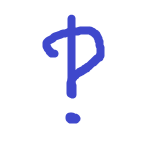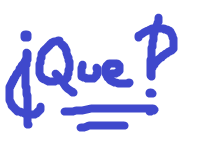Dear Language Nerd,
Back when I was in school, we studied the interrobang, a question mark and exclamation point put together. But I haven’t seen it since, and so I ask you: whither the interrobang‽
Yours,
Erwin Munz
***
Dear Erwin,
As far as I can tell, you were in the definite minority in studying the interrobang in school. I suppose your teacher was an early adopter (though if other readers studied it back in the day, let me know!). The interrobang was invented in 1962 by typesetter Martin Speckter, who wanted to both wonder (“interro” being Latin for “question,” as in “interrogation”) and holler (“bang” being, besides noisy, slang for an exclamation mark amongst those who really wanted slang for an exclamation mark, mostly printers) at the same time. His smushed-together creation was in vogue for the rest of the decade, made it onto a few typewriters, and even had some members of the following calling for an upside-down version so that Spanish speakers could show proper levels of emotion at both ends of their sentences. But the interrobang bubble soon burst.
What happened? Well, the interrobang just isn’t all that useful. Although this ancient but proud website calls ?! and !? “typographically cumbersome and unattractive combinations of the question mark and exclamation mark,” which only the interrobang can rescue us from, the rest of us seem to consider ?! a lovely way to end an excited but incredulous sentence. In fact, I find the interrobang itself rather unpleasant, since if you’re not paying close attention it looks like someone was putting all the periods in bold type and accidentally got a question mark too. (Don’t pretend you’ve never tried to increase the page count in your report by bolding all the periods. The Language Nerd always knows… and sympathizes.) The interrobang isn’t different enough from other punctuation to be easily distinguished on the page, and it isn’t necessary. The role it fills is easily taken by other, better-known, simpler marks. Nowadays, even this interview about the interrobang uses ?! instead of ‽, and this magazine, The Interrobang, the very first google hit for interrobang after Wikipedia, uses !? for its logo instead of an actual interrobang. It’s just not worth it.

The love mark, authority mark, and acclamation point, all invented by Herve Bazin. Gotta respect the guy for trying. Then three variations on the irony point, all by different dudes.
Novelty punctuation rarely lasts, and better contenders than the interrobang have vied for a spot in English-speakers’ hearts (and our unicode). The love mark, for example, was two question marks put together (to make a heart shape, though the level of uncertainty that implies is probably not what you want to mark your recently-plighted troth). An exclamation with a curved hat meant that you definitely for real had a source for what you just said, or are yourself a first-class authority (okay, that one actually sounds pretty good, let’s imagine those on the end of all my sentences, hmm?). Two exclamation points sharing one dot, like bunny ears, were an acclamation point. And at least three designs reminiscent of backwards question marks have been introduced as irony points, the first one in the 1500s, so let no one tell you that modern society is drastically more cynical than its forebears.
These marks fare much better than the interrobang on the second point, readability, but have similar problems as far as usefulness. We just don’t need to clarify our undying love mid-email all that often, and when we do, we use what we already have: <3 If we want to acclaim something more than we do with one exclamation point, we’ll find a way (I believe in us!!!!!!!). And if we want to show sarcasm, well, I can’t imagine how we could possibly do that. The takeaway: if you’re looking to invent new punctuation (and who isn’t?), first make sure that it’s something we need to be able to express, then make sure you can’t express it with what’s already on the keyboard.
Spanish speakers, to break the agonizing suspense since that first paragraph, usually use an inverted question mark and exclamation mark at both ends — ¿¡Que?! Though they do also have the classy option of using a question mark on one end and an exclamation on the other – ¿Que! or ¡Que?
Any more questions‽‽‽
Yours,
The Language Nerd
Got a language question? Ask the Language Nerd! asktheleagueofnerds@gmail.com
Or: Twitter @AskTheLeague / facebook.com/asktheleagueofnerds
References this week include the article mentioned above for most of the history bits, this oddity for the marks made by Bazin, and Wikipedia for the various irony points and the Spanish info.
UPDATE UPDATE! Breaking news, people. Last week, I brought up the story of the Crewe of Columbus, the odd man out (spelling-wise) of the many Mardi Gras Krewes. Here’s the saliant part of what I wrote then:
I have an update on uses and spellings of the Mardi Gras word “krewe.” Someone noted that the Crewe of Columbus eschews this spelling, but doesn’t go so far as to return to “crew.” The story is this: the group was originally formed in 1922 as the Krewe of Columbus, in keeping with Carnival best practices. This had the additional bonus of giving the group the same initials as the Knights of Columbus, the very very Catholic organization that the Krewe took its members from. When the group opened its membership to a wider group of people in 1937, they changed the spelling to Crewe to remove that same-acronym connection with the Knights, and the two groups went their separate ways.
Since that was published, certain inside informants have suggested to me that this is not the whole story. That, in fact, the group “opening its membership” was not so much a choice of the Krewe/Crewe themeslves, but rather forced upon them by the Bishop, because they had a tendency towards riotous behavior (also in keeping with Carnival best practices). The name change was also forced, not because the Crewe was looking to loosen ties, but because the Bishop didn’t want the acronym association with his Knights. Stay tuned, everybody, we are gonna bust this case wide open.

